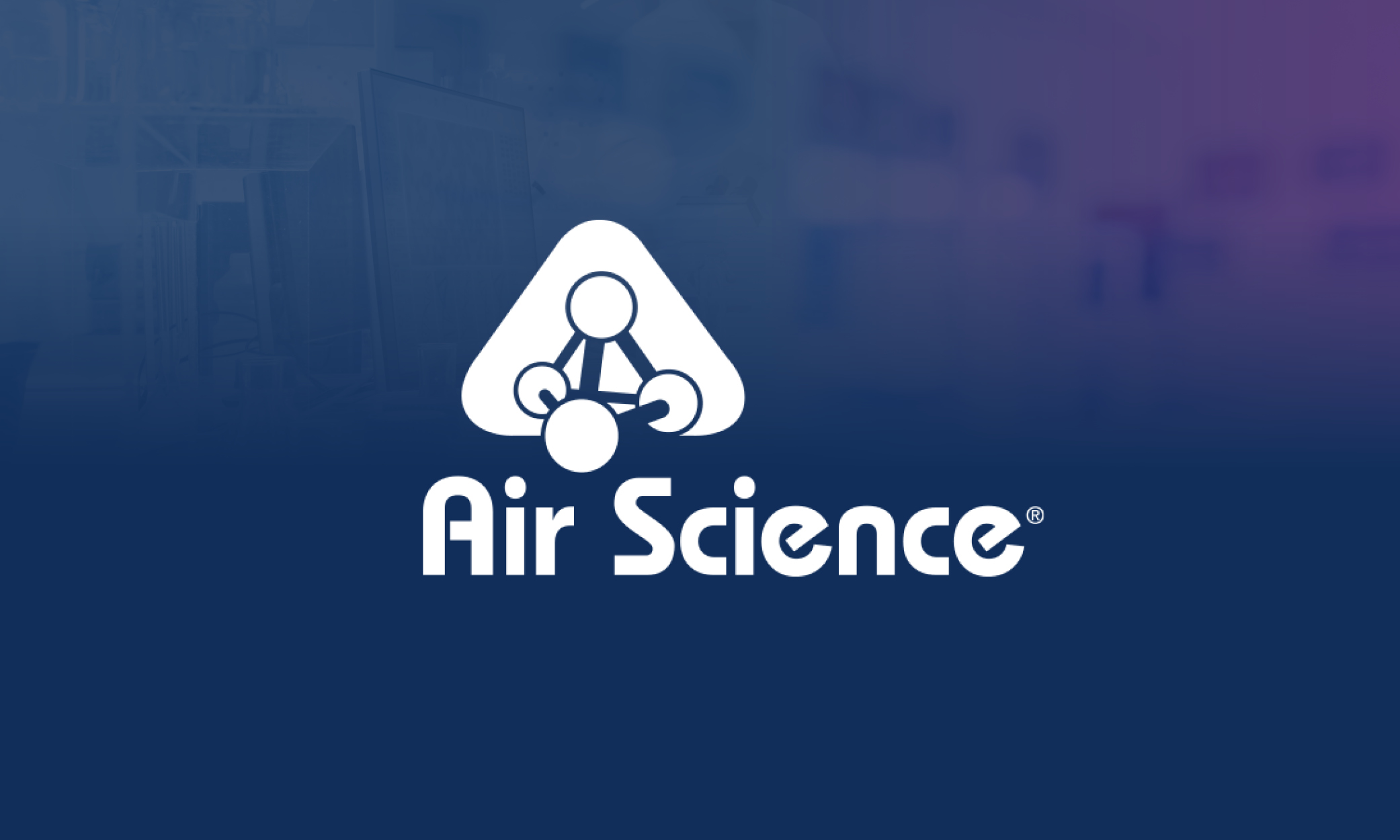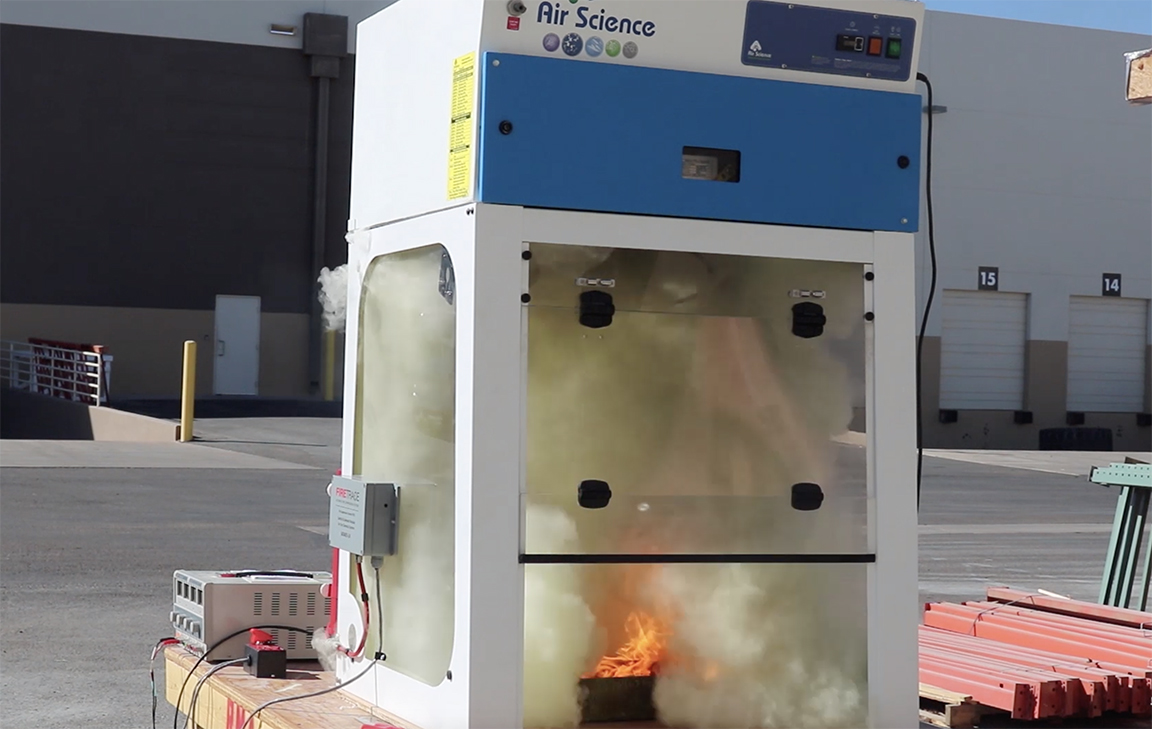
While ductless fume hoods are good at controlling the risk of fume inhalation, those same contaminants that a ductless fume hood is protecting the operator, environment and equipment from, can also contribute to the risk of a fire. Fume hoods should not only protect the users from potential chemical contamination, but should also have built-in measures to protect against potential fire hazards.
This is why proper laboratory fire management protocols are crucial to maintaining personnel safety. The integration of engineered solutions to control fires is an important fail safe that can help improve operator safety and protect business investment. Fire suppression systems, such as those offered by Air Science, can be included as an option for ductless fume hoods, laboratory glove boxes and hazardous material storage cabinets.
Fume Hood Fire Suppression
Fire management systems, in particular fire suppression systems, are an important aspect of any laboratory safety program. Air Science ductless fume hoods have an available option for either Direct Low Pressure (DLP) or Indirect Low Pressure (ILP) suppression solutions.
Direct Low Pressure System
A DLP system automatically releases an extinguishing agent if a fire breaks out on the work surface. Polymer tubing used to deliver fire suppression agent is flexible and heat sensitive, designed to burst when it senses heat or upon direct flame impingement. The tubing is mounted above the work surface and is configured to release an extinguishing agent once the temperature at any point in the tubing reaches 375°F. The tubing provides 360 degrees of fire detection, allowing automatic release of fire suppressing agent through nozzles placed in strategic internal locations.
The extinguishing agent powder is stored at a pressure of 195 PSI in a canister mounted adjacent to the hood. A selection of dry powder extinguishing agents can be customized to suit the application.
The system is pneumatic and does not require an electrical power source to operate. The extinguishing agent can be recharged as needed and should be monitored via the installed pressure gauge monthly to ensure no leaks have occurred. An inline pressure switch can also be installed for remote monitoring and alarms.
Indirect Low Pressure System
Air Science ductless fume hoods can also be equipped with an ILP fire suppression system which incorporates all of the features of the DLP system, but includes a manual release option for operator intervention in the event of a fire.
Testing and Results
Air Science recently performed a series of controlled field tests on the DLP fire suppression system on select Purair® Advanced series ductless fume hoods. The tests demonstrated a high level of effectiveness in the event of both small and larger fires on the work surface, controlling and extinguishing the fires within seconds of ignition.
The ductless fume hood is designed to operate during and following the release of the extinguishing agent, ensuring all fumes and smoke are contained within the enclosure to help protect operators and minimize damage to the laboratory. To see the video, visit /template_video.php?id=1.jpg) Large Fire Suppression
Large Fire Suppression Small Fire Suppression
Small Fire Suppression
Benefits
The DLP and ILP fire suppression systems available for installation in Air Science ductless fume hoods provide numerous benefits.
- Speed of Detection. Placement of the fire suppression system in the path of heat and flame assures extremely fast, automatic detection and suppression of fire (often 10x more than conventional detection systems). Faster detection means less time burning and lower potential for damage to life and property.
- Automatic Fire Detection and Suppression. The Air Science fire suppression systems deliver constant fire detection and suppression, without human intervention. The systems require no electricity to operate, can be remote monitored, and can include a manual release.
- Multiple Safety Functions. The DLP and ILP fire suppression systems can be equipped with pressure switches to activate local and/or building alarms. The pressure switches can also be connected to other automatic shut off valves or equipment to shut down an entire process in the event of fire, further protecting the facility, equipment and personnel.
Granular Activated Carbon Filters: Fire Mitigation
Air Science carbon filters are based on enhanced, activated carbon granule formulations from specially selected, naturally occurring raw material superior to wood or other organic sources. Our carbon is treated to attain the proper porosity and aggregate surface area and to react with several ranges of aerosolized chemicals moved through the filter by an air handling blower.
Granular activated carbon filters provide significant additional fire suppression benefits over their bonded carbon filter counterparts. Should a fire event take place in a ductless fume hood, the carbon from the granular activated filter is designed to release directly onto the fire and quickly extinguish the flame.
Read our Carbon Filtration Whitepaper and learn more on the benefit of granular carbon vs. bonded carbon.
Detecting a fire in its initial stages is critical in minimizing injury to personnel and damage to equipment and property. A metal substructure construction with fire suppression systems by Air Science help detect and suppress fire inside ductless fume hoods before it can grow out of control.
Fire suppression systems can be customized to meet nearly any application. Associated solutions include remote monitoring, emergency equipment shut-off, centralized alarms, and automatic activation, all without human intervention or power requirements.
View our Ductless Fume Hood products and features and get a quote today.
Resources

Fire Suppression Application Note

Ductless Fume Hoods Fire Safety Whitepaper

Watch Our Webinar: Managing a Work Surface Fire in a Ductless Fume Hood